NASA APOD #975-982
#975 M27: The Dumbbell Nebula February 18, 1998
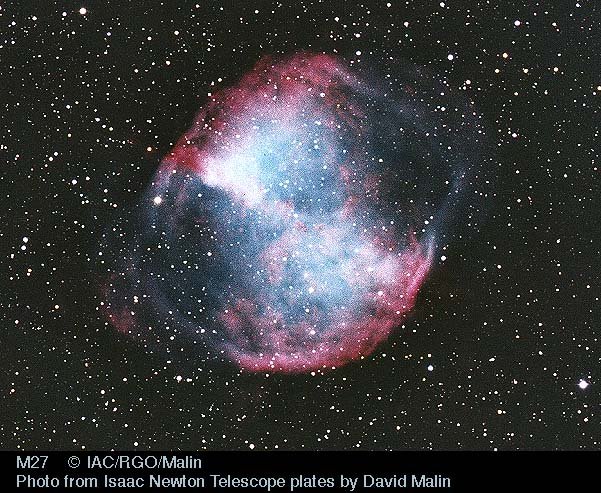
“The first hint of what will become of our Sun was discovered inadvertently in 1764. At that time, Charles Messier was compiling a list of "annoying" diffuse objects not to be confused with "interesting" comets. The 27th object on Messier's list, now known as M27 or the Dumbbell Nebula, is a planetary nebula, the type of nebula our Sun will produce when nuclear fusion stops in its core. M27 is one of the brightest planetary nebulae on the sky, and can be seen in the constellation Vulpecula with binoculars. It takes light about 1000 years to reach us from M27. Understanding the physics and significance of M27 was well beyond 18th century science. Even today, many things remain mysterious about bipolar planetary nebula like M27, including the physical mechanism that expels a low-mass star's gaseous outer-envelope, leaving an X-ray hot white dwarf."
Copyright: Public domain
#976 Miranda February 19, 1998
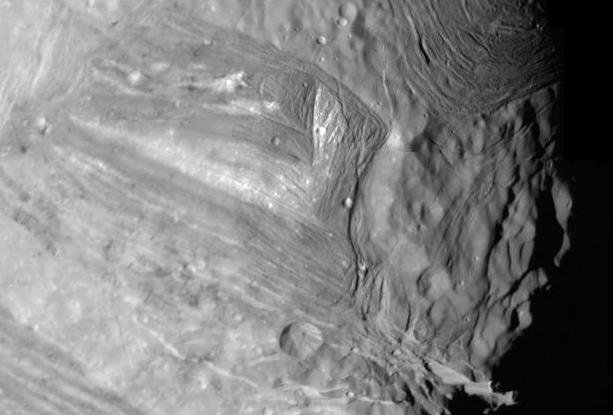
“Miranda is a bizarre world which surely had a tempestuous past. The innermost of the larger Uranian moons, Miranda is almost 300 miles in diameter and was discovered only 50 years ago (February 16, 1948) by the renown American planetary astronomer Gerard Kuiper. Examined very closely by the Voyager 2 spacecraft in 1986, this dark and distant world turned out to be quite a surprise. Miranda was found to display a unique, bewildering variety of terrain leading some to suggest that it has been fractured up to 5 times during its evolution. Along with the famous "chevron" feature, the bright V-shaped area just above center, this composite of the highest resolution images of Miranda shows wild juxtapositions of ridges and valleys, older cratered and younger smooth surfaces, and shadowy canyons perhaps 12 miles deep. The large crater (below center) is the 15 mile wide crater Alonso."
Copyright: Public domain
#977 Hale-Bopp: A Continuing Tail February 20, 1998
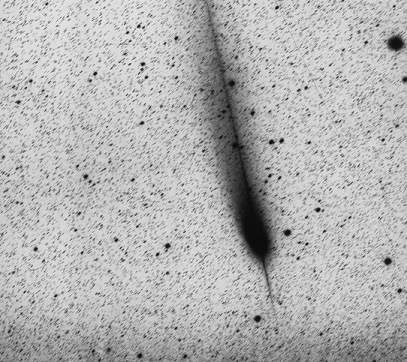
“Where is Hale-Bopp now? The Great Comet of 1997, one of the largest and most active comets ever, is outbound about 400 million miles from the sun. Too faint for viewing without telescopes or binoculars, Hale-Bopp is presently positioned in the very southerly constellation of Pictor. This "negative" image (black stars against white sky) of Hale-Bopp is the result of a 1 hour time exposure using the 1-metre European Southern Observatory Schmidt telescope on January 5. Clearly the comet still has a substantial tail, blown by the solar wind, that points generally away from the sunward direction. But look closely. A spiky "anti-tail" is also visible pointing toward the sun! It is likely that this anti-tail is composed of dust grains released from the comet nucleus which are too large to be easily pushed by the solar wind. As Hale-Bopp recedes from the sun its activity will subside but astronomers are still uncertain as to how long its tails will last. After a swing through the outer solar system and the Oort cloud, Hale-Bopp will pass through the inner solar system again ... around the year 5400."
Copyright: Public domain
#978 Neptune: Big Blue Giant February 21, 1998
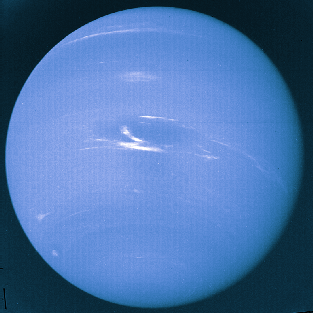
“This picture was taken by the Voyager 2 spacecraft in 1989 - the only spacecraft ever to visit Neptune. Neptune will be the farthest planet from the Sun until 1999, when the elliptical orbit of Pluto will cause it to once again resume this status. Neptune, like Uranus, is composed mostly of liquid water, methane and ammonia, is surrounded by a thick gas atmosphere of mostly hydrogen and helium, and has many moons and rings. Neptune's moon Triton is unlike any other and has active volcanoes. The nature of Triton's unusual orbit around Neptune is the focus of much discussion and speculation."
Copyright: Public domain
#979 Southern Lights and Shuttle Glow February 22, 1998
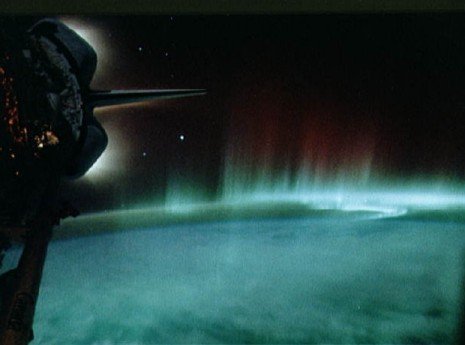
“A background of distant stars, sinuous and spiky bands of Southern Lights (Aurora Australis), and the faint glow of charged plasma (ionized atomic gas) surrounding the Space Shuttle Discovery's engines give this photo from the STS-39 mission an eerie, otherworldly look. This image reflects Discovery's April 1991 mission well - its payload bay (PLB) was filled with instruments designed to study celestial objects, aurora and atmospheric phenomena, and the low Earth orbit environment around the PLB itself. The aurora seen here are at a height of about 50-80 miles. Aurora are caused by charged particles in the solar wind, channeled through the Earth's magnetic field which excite molecules in the upper atmosphere."
Copyright: Public domain
#980 M104: The Sombrero Galaxy February 23, 1998
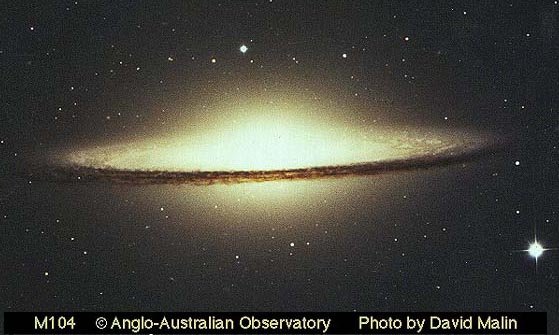
“What's going on in the center of this spiral galaxy? Named the Sombrero Galaxy for its hat-like resemblance, M104 features a prominent dust lane and a bright halo of stars and globular clusters. Something truly energetic is going on in the Sombrero's center, as it not only appears bright in visible light, but glows prodigiously in X-ray light as well. This X-ray emission coupled with unusually high central stellar speeds cause many astronomers to speculate that a black hole lies at the Sombrero's center - a black hole possibly a billion times the mass of our Sun."
Copyright: Public domain
#981 The Lyman Alpha Forest February 24, 1998
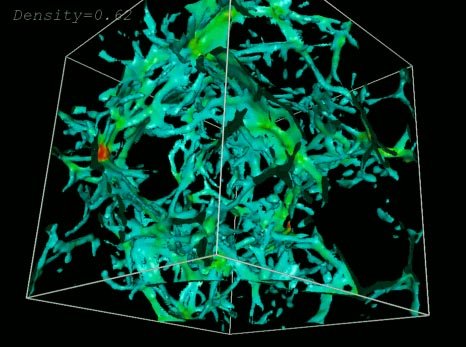
“We live in a forest. Strewn throughout the universe are "trees" of hydrogen gas that absorb light from distant objects. These gas clouds leave numerous absorption lines in a distant quasar's spectra, together called the Lyman-alpha forest. Distant quasars appear to be absorbed by many more Lyman-alpha clouds than nearby quasars, indicating a Lyman-alpha thicket early in our universe. The above image depicts one possible computer realization of how Lyman-alpha clouds were distributed at a redshift of 3. Each side of the box measures 30 million light-years across. Much remains unknown about the Lyman-alpha forest, including the real geometry and extent of the clouds, and why there are so many fewer clouds today."
Copyright: UIUCGCCC
#982 The Solar Neighborhood February 25, 1998
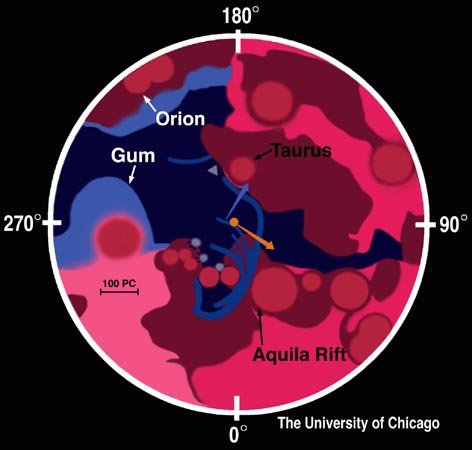
“You are here. The orange dot in the above false-color drawing represents the current location of the Sun among local gas clouds in the spiral Milky Way Galaxy. These gas clouds are so thin that we usually see right through them. Nearly spherical bubbles surround regions of recent star formation. The purple filaments near the Sun are gas shells resulting from star formation 4 million years ago in the Scorpius-Centaurus Association, located to the Sun's lower left. The Sun has been between spiral arms moving through relatively low density gas for the past 5 million years. In contrast, the Sun oscillates in the Milky Way plane every 66 million years, and circles the Galactic Center every 250 million years."
Copyright: U. Chicago
Upvote! Resteem! Comment! As you like it! Thank you for attention!